Argentina or Colombia? A Comparative Investment Opportunity Report
VerifiedAdded on 2020/05/04
|16
|3439
|99
Report
AI Summary
This report provides a comparative analysis of Argentina and Colombia as potential investment destinations for an Australian company focused on socially responsible commerce. The report addresses the CEO's challenge of selecting a Latin American country, considering factors such as market size, specialized training services, innovation capacity, and business costs of terrorism. Utilizing the WEF 2016-2017 report and economic development concepts, the analysis evaluates the countries' competitiveness based on the Global Competitiveness Index (GCI), economic development path, and competitive advantages. The report highlights Argentina's strengths in market size, innovation, and business costs of terrorism, ultimately recommending it as the more suitable investment option. The analysis delves into various pillars of the GCI, including institutions, infrastructure, macroeconomic environment, and innovation, to provide a detailed comparison and justify the recommendation. The report also evaluates the relevant rules for evaluating competitiveness, including the capacity to innovate and upgrade, which contribute to competitive advantage. The analysis concludes with the recommendation of Argentina based on its competitive advantages and the CEO's requirements.
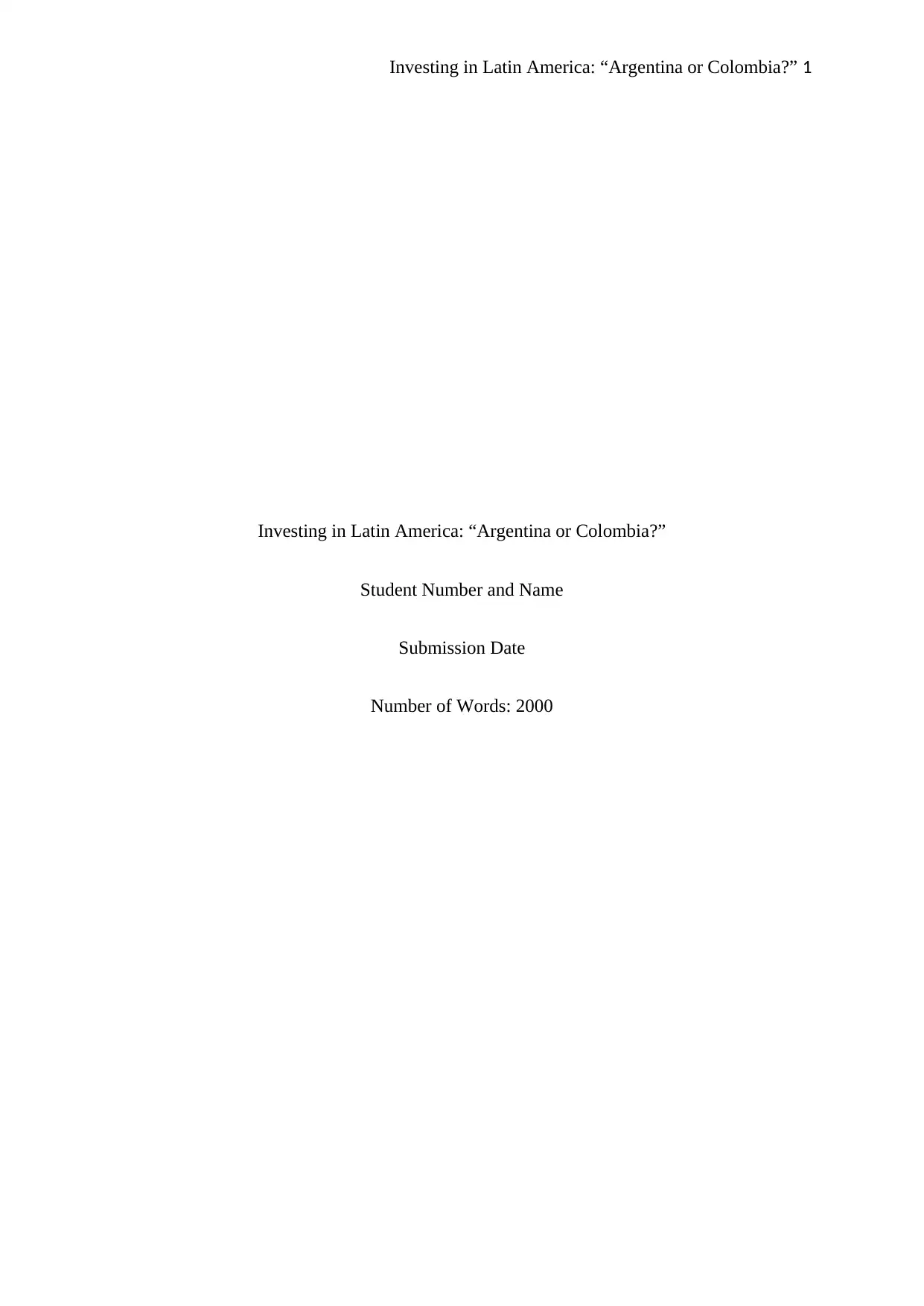
Investing in Latin America: “Argentina or Colombia?” 1
Investing in Latin America: “Argentina or Colombia?”
Student Number and Name
Submission Date
Number of Words: 2000
Investing in Latin America: “Argentina or Colombia?”
Student Number and Name
Submission Date
Number of Words: 2000
Paraphrase This Document
Need a fresh take? Get an instant paraphrase of this document with our AI Paraphraser
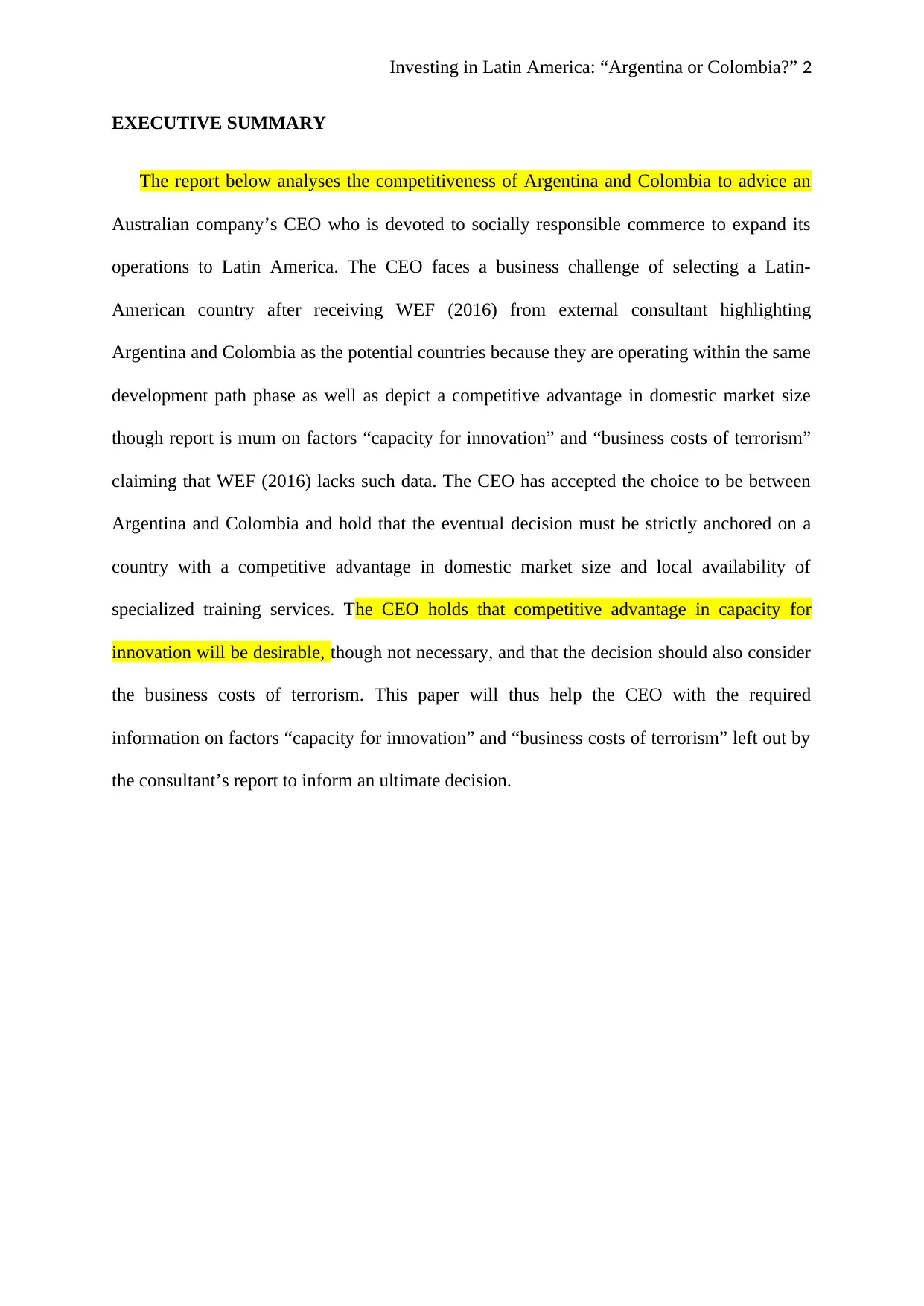
Investing in Latin America: “Argentina or Colombia?” 2
EXECUTIVE SUMMARY
The report below analyses the competitiveness of Argentina and Colombia to advice an
Australian company’s CEO who is devoted to socially responsible commerce to expand its
operations to Latin America. The CEO faces a business challenge of selecting a Latin-
American country after receiving WEF (2016) from external consultant highlighting
Argentina and Colombia as the potential countries because they are operating within the same
development path phase as well as depict a competitive advantage in domestic market size
though report is mum on factors “capacity for innovation” and “business costs of terrorism”
claiming that WEF (2016) lacks such data. The CEO has accepted the choice to be between
Argentina and Colombia and hold that the eventual decision must be strictly anchored on a
country with a competitive advantage in domestic market size and local availability of
specialized training services. The CEO holds that competitive advantage in capacity for
innovation will be desirable, though not necessary, and that the decision should also consider
the business costs of terrorism. This paper will thus help the CEO with the required
information on factors “capacity for innovation” and “business costs of terrorism” left out by
the consultant’s report to inform an ultimate decision.
EXECUTIVE SUMMARY
The report below analyses the competitiveness of Argentina and Colombia to advice an
Australian company’s CEO who is devoted to socially responsible commerce to expand its
operations to Latin America. The CEO faces a business challenge of selecting a Latin-
American country after receiving WEF (2016) from external consultant highlighting
Argentina and Colombia as the potential countries because they are operating within the same
development path phase as well as depict a competitive advantage in domestic market size
though report is mum on factors “capacity for innovation” and “business costs of terrorism”
claiming that WEF (2016) lacks such data. The CEO has accepted the choice to be between
Argentina and Colombia and hold that the eventual decision must be strictly anchored on a
country with a competitive advantage in domestic market size and local availability of
specialized training services. The CEO holds that competitive advantage in capacity for
innovation will be desirable, though not necessary, and that the decision should also consider
the business costs of terrorism. This paper will thus help the CEO with the required
information on factors “capacity for innovation” and “business costs of terrorism” left out by
the consultant’s report to inform an ultimate decision.
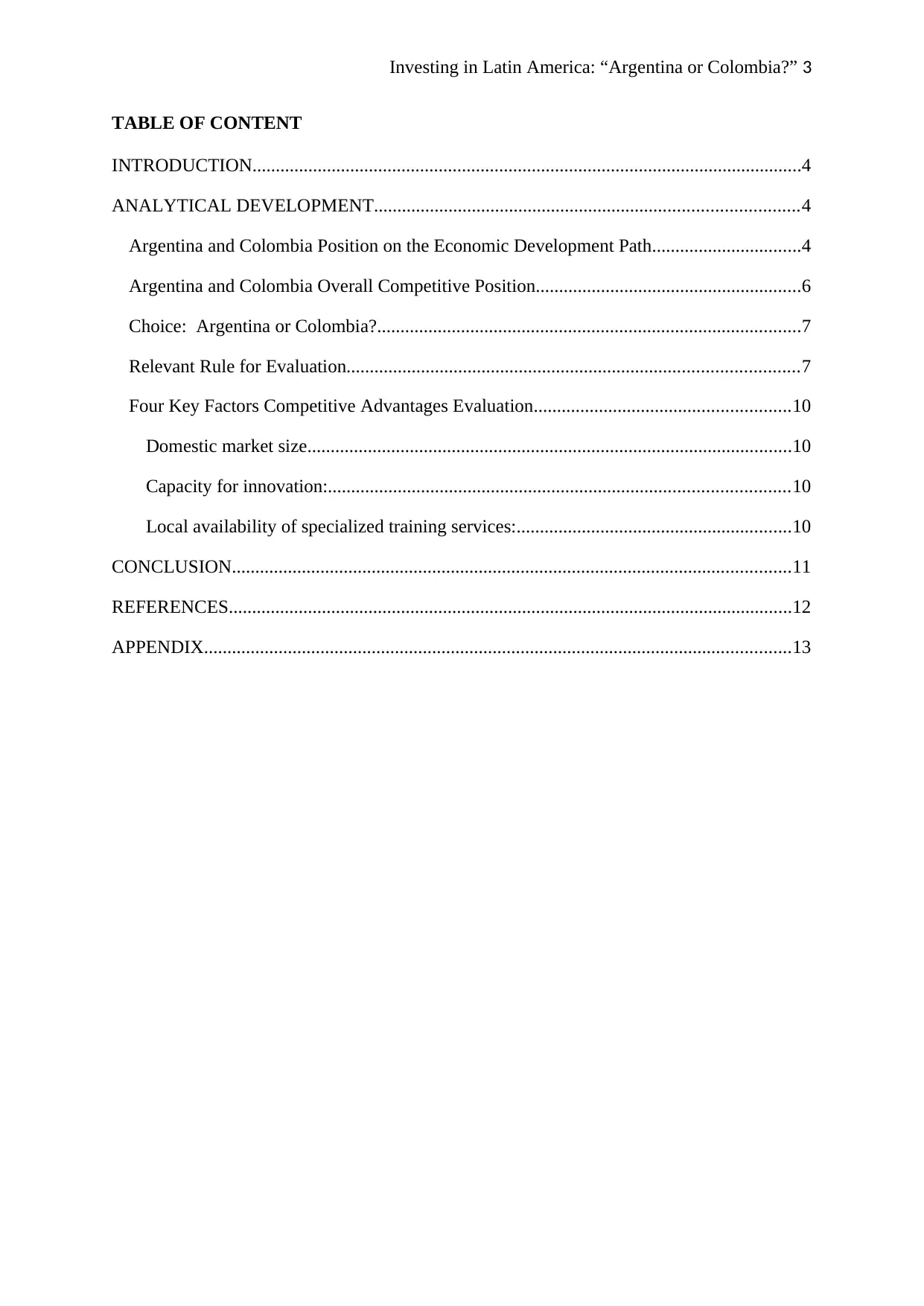
Investing in Latin America: “Argentina or Colombia?” 3
TABLE OF CONTENT
INTRODUCTION......................................................................................................................4
ANALYTICAL DEVELOPMENT...........................................................................................4
Argentina and Colombia Position on the Economic Development Path................................4
Argentina and Colombia Overall Competitive Position.........................................................6
Choice: Argentina or Colombia?...........................................................................................7
Relevant Rule for Evaluation.................................................................................................7
Four Key Factors Competitive Advantages Evaluation.......................................................10
Domestic market size........................................................................................................10
Capacity for innovation:...................................................................................................10
Local availability of specialized training services:...........................................................10
CONCLUSION........................................................................................................................11
REFERENCES.........................................................................................................................12
APPENDIX..............................................................................................................................13
TABLE OF CONTENT
INTRODUCTION......................................................................................................................4
ANALYTICAL DEVELOPMENT...........................................................................................4
Argentina and Colombia Position on the Economic Development Path................................4
Argentina and Colombia Overall Competitive Position.........................................................6
Choice: Argentina or Colombia?...........................................................................................7
Relevant Rule for Evaluation.................................................................................................7
Four Key Factors Competitive Advantages Evaluation.......................................................10
Domestic market size........................................................................................................10
Capacity for innovation:...................................................................................................10
Local availability of specialized training services:...........................................................10
CONCLUSION........................................................................................................................11
REFERENCES.........................................................................................................................12
APPENDIX..............................................................................................................................13
⊘ This is a preview!⊘
Do you want full access?
Subscribe today to unlock all pages.

Trusted by 1+ million students worldwide
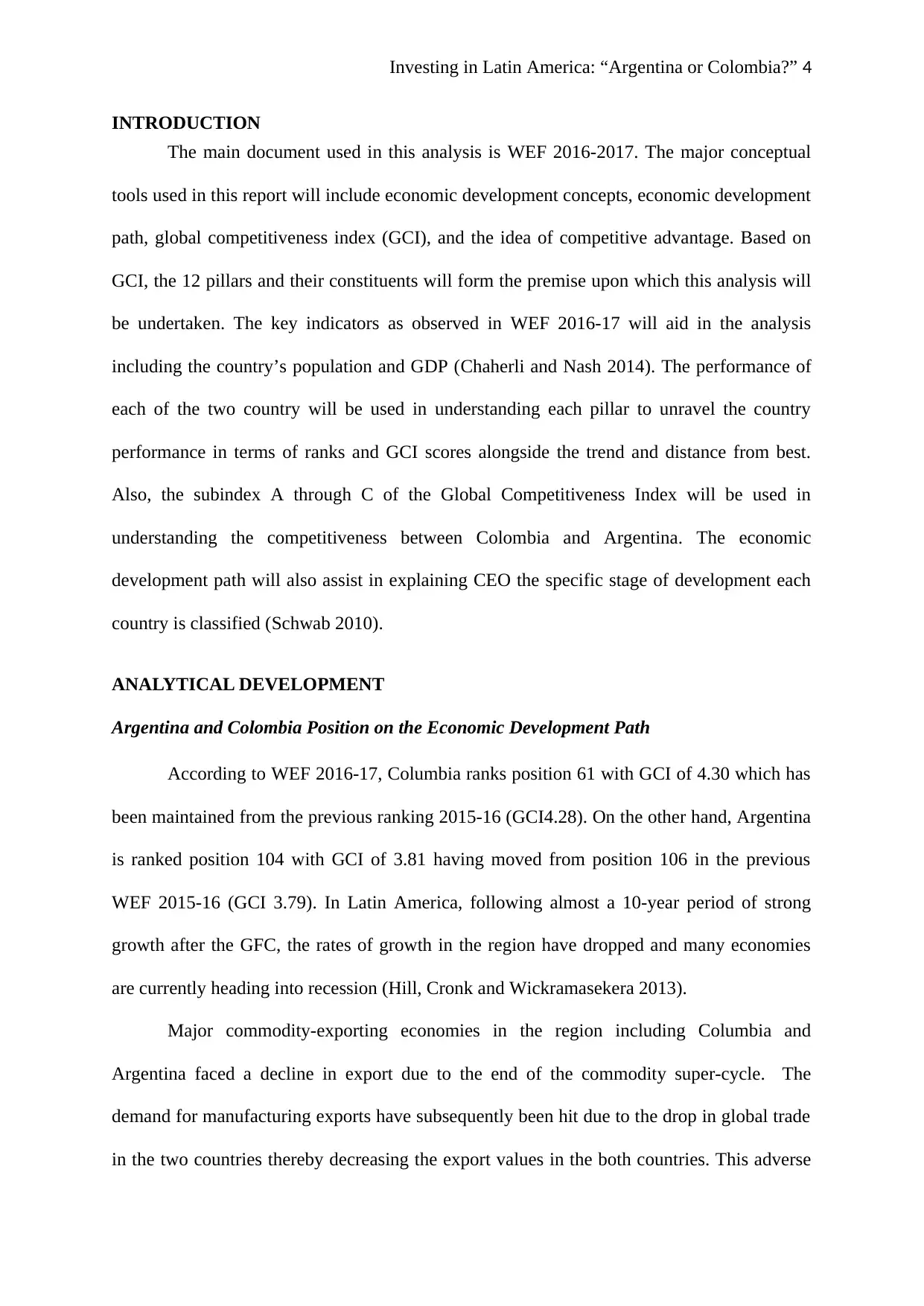
Investing in Latin America: “Argentina or Colombia?” 4
INTRODUCTION
The main document used in this analysis is WEF 2016-2017. The major conceptual
tools used in this report will include economic development concepts, economic development
path, global competitiveness index (GCI), and the idea of competitive advantage. Based on
GCI, the 12 pillars and their constituents will form the premise upon which this analysis will
be undertaken. The key indicators as observed in WEF 2016-17 will aid in the analysis
including the country’s population and GDP (Chaherli and Nash 2014). The performance of
each of the two country will be used in understanding each pillar to unravel the country
performance in terms of ranks and GCI scores alongside the trend and distance from best.
Also, the subindex A through C of the Global Competitiveness Index will be used in
understanding the competitiveness between Colombia and Argentina. The economic
development path will also assist in explaining CEO the specific stage of development each
country is classified (Schwab 2010).
ANALYTICAL DEVELOPMENT
Argentina and Colombia Position on the Economic Development Path
According to WEF 2016-17, Columbia ranks position 61 with GCI of 4.30 which has
been maintained from the previous ranking 2015-16 (GCI4.28). On the other hand, Argentina
is ranked position 104 with GCI of 3.81 having moved from position 106 in the previous
WEF 2015-16 (GCI 3.79). In Latin America, following almost a 10-year period of strong
growth after the GFC, the rates of growth in the region have dropped and many economies
are currently heading into recession (Hill, Cronk and Wickramasekera 2013).
Major commodity-exporting economies in the region including Columbia and
Argentina faced a decline in export due to the end of the commodity super-cycle. The
demand for manufacturing exports have subsequently been hit due to the drop in global trade
in the two countries thereby decreasing the export values in the both countries. This adverse
INTRODUCTION
The main document used in this analysis is WEF 2016-2017. The major conceptual
tools used in this report will include economic development concepts, economic development
path, global competitiveness index (GCI), and the idea of competitive advantage. Based on
GCI, the 12 pillars and their constituents will form the premise upon which this analysis will
be undertaken. The key indicators as observed in WEF 2016-17 will aid in the analysis
including the country’s population and GDP (Chaherli and Nash 2014). The performance of
each of the two country will be used in understanding each pillar to unravel the country
performance in terms of ranks and GCI scores alongside the trend and distance from best.
Also, the subindex A through C of the Global Competitiveness Index will be used in
understanding the competitiveness between Colombia and Argentina. The economic
development path will also assist in explaining CEO the specific stage of development each
country is classified (Schwab 2010).
ANALYTICAL DEVELOPMENT
Argentina and Colombia Position on the Economic Development Path
According to WEF 2016-17, Columbia ranks position 61 with GCI of 4.30 which has
been maintained from the previous ranking 2015-16 (GCI4.28). On the other hand, Argentina
is ranked position 104 with GCI of 3.81 having moved from position 106 in the previous
WEF 2015-16 (GCI 3.79). In Latin America, following almost a 10-year period of strong
growth after the GFC, the rates of growth in the region have dropped and many economies
are currently heading into recession (Hill, Cronk and Wickramasekera 2013).
Major commodity-exporting economies in the region including Columbia and
Argentina faced a decline in export due to the end of the commodity super-cycle. The
demand for manufacturing exports have subsequently been hit due to the drop in global trade
in the two countries thereby decreasing the export values in the both countries. This adverse
Paraphrase This Document
Need a fresh take? Get an instant paraphrase of this document with our AI Paraphraser
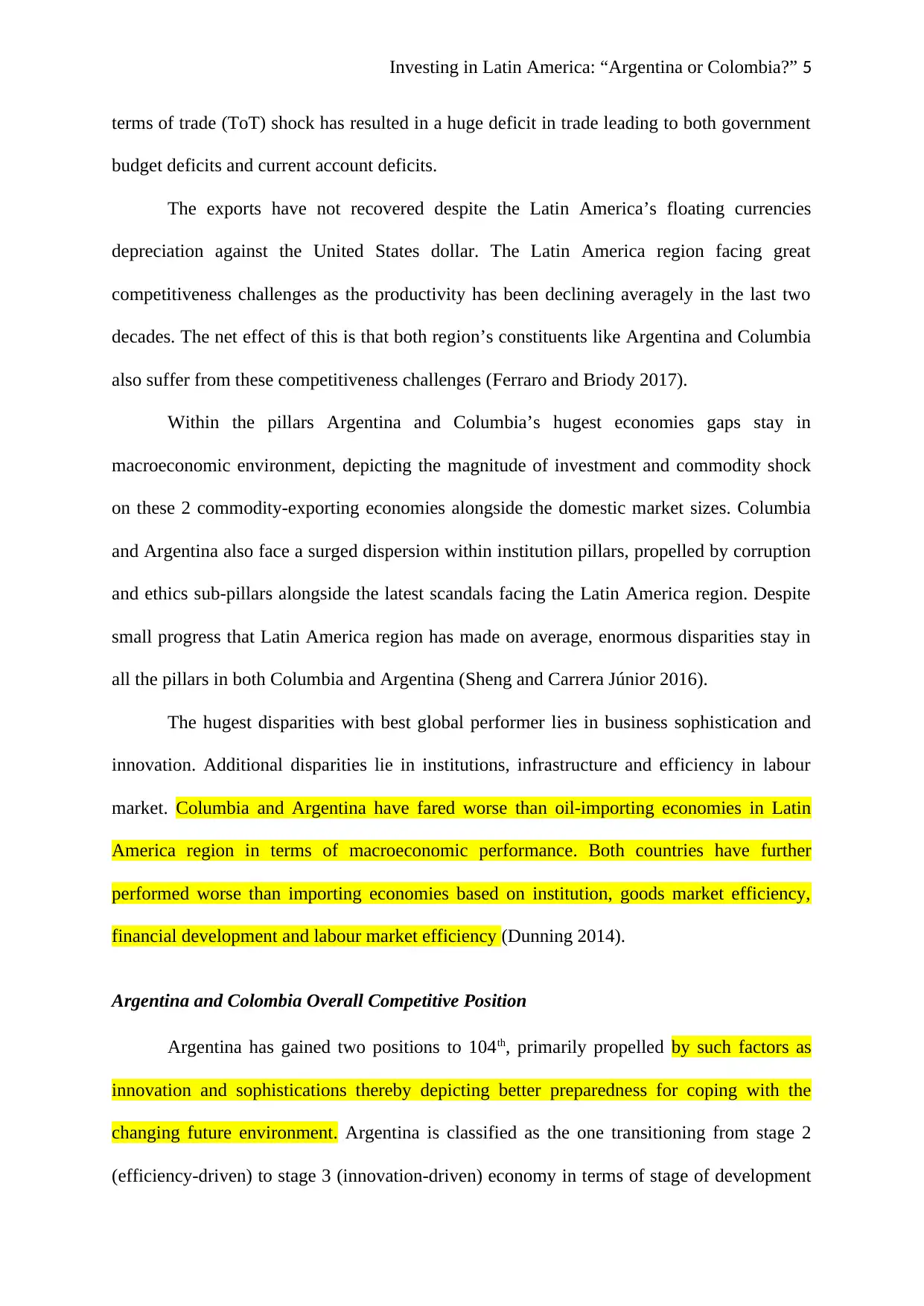
Investing in Latin America: “Argentina or Colombia?” 5
terms of trade (ToT) shock has resulted in a huge deficit in trade leading to both government
budget deficits and current account deficits.
The exports have not recovered despite the Latin America’s floating currencies
depreciation against the United States dollar. The Latin America region facing great
competitiveness challenges as the productivity has been declining averagely in the last two
decades. The net effect of this is that both region’s constituents like Argentina and Columbia
also suffer from these competitiveness challenges (Ferraro and Briody 2017).
Within the pillars Argentina and Columbia’s hugest economies gaps stay in
macroeconomic environment, depicting the magnitude of investment and commodity shock
on these 2 commodity-exporting economies alongside the domestic market sizes. Columbia
and Argentina also face a surged dispersion within institution pillars, propelled by corruption
and ethics sub-pillars alongside the latest scandals facing the Latin America region. Despite
small progress that Latin America region has made on average, enormous disparities stay in
all the pillars in both Columbia and Argentina (Sheng and Carrera Júnior 2016).
The hugest disparities with best global performer lies in business sophistication and
innovation. Additional disparities lie in institutions, infrastructure and efficiency in labour
market. Columbia and Argentina have fared worse than oil-importing economies in Latin
America region in terms of macroeconomic performance. Both countries have further
performed worse than importing economies based on institution, goods market efficiency,
financial development and labour market efficiency (Dunning 2014).
Argentina and Colombia Overall Competitive Position
Argentina has gained two positions to 104th, primarily propelled by such factors as
innovation and sophistications thereby depicting better preparedness for coping with the
changing future environment. Argentina is classified as the one transitioning from stage 2
(efficiency-driven) to stage 3 (innovation-driven) economy in terms of stage of development
terms of trade (ToT) shock has resulted in a huge deficit in trade leading to both government
budget deficits and current account deficits.
The exports have not recovered despite the Latin America’s floating currencies
depreciation against the United States dollar. The Latin America region facing great
competitiveness challenges as the productivity has been declining averagely in the last two
decades. The net effect of this is that both region’s constituents like Argentina and Columbia
also suffer from these competitiveness challenges (Ferraro and Briody 2017).
Within the pillars Argentina and Columbia’s hugest economies gaps stay in
macroeconomic environment, depicting the magnitude of investment and commodity shock
on these 2 commodity-exporting economies alongside the domestic market sizes. Columbia
and Argentina also face a surged dispersion within institution pillars, propelled by corruption
and ethics sub-pillars alongside the latest scandals facing the Latin America region. Despite
small progress that Latin America region has made on average, enormous disparities stay in
all the pillars in both Columbia and Argentina (Sheng and Carrera Júnior 2016).
The hugest disparities with best global performer lies in business sophistication and
innovation. Additional disparities lie in institutions, infrastructure and efficiency in labour
market. Columbia and Argentina have fared worse than oil-importing economies in Latin
America region in terms of macroeconomic performance. Both countries have further
performed worse than importing economies based on institution, goods market efficiency,
financial development and labour market efficiency (Dunning 2014).
Argentina and Colombia Overall Competitive Position
Argentina has gained two positions to 104th, primarily propelled by such factors as
innovation and sophistications thereby depicting better preparedness for coping with the
changing future environment. Argentina is classified as the one transitioning from stage 2
(efficiency-driven) to stage 3 (innovation-driven) economy in terms of stage of development
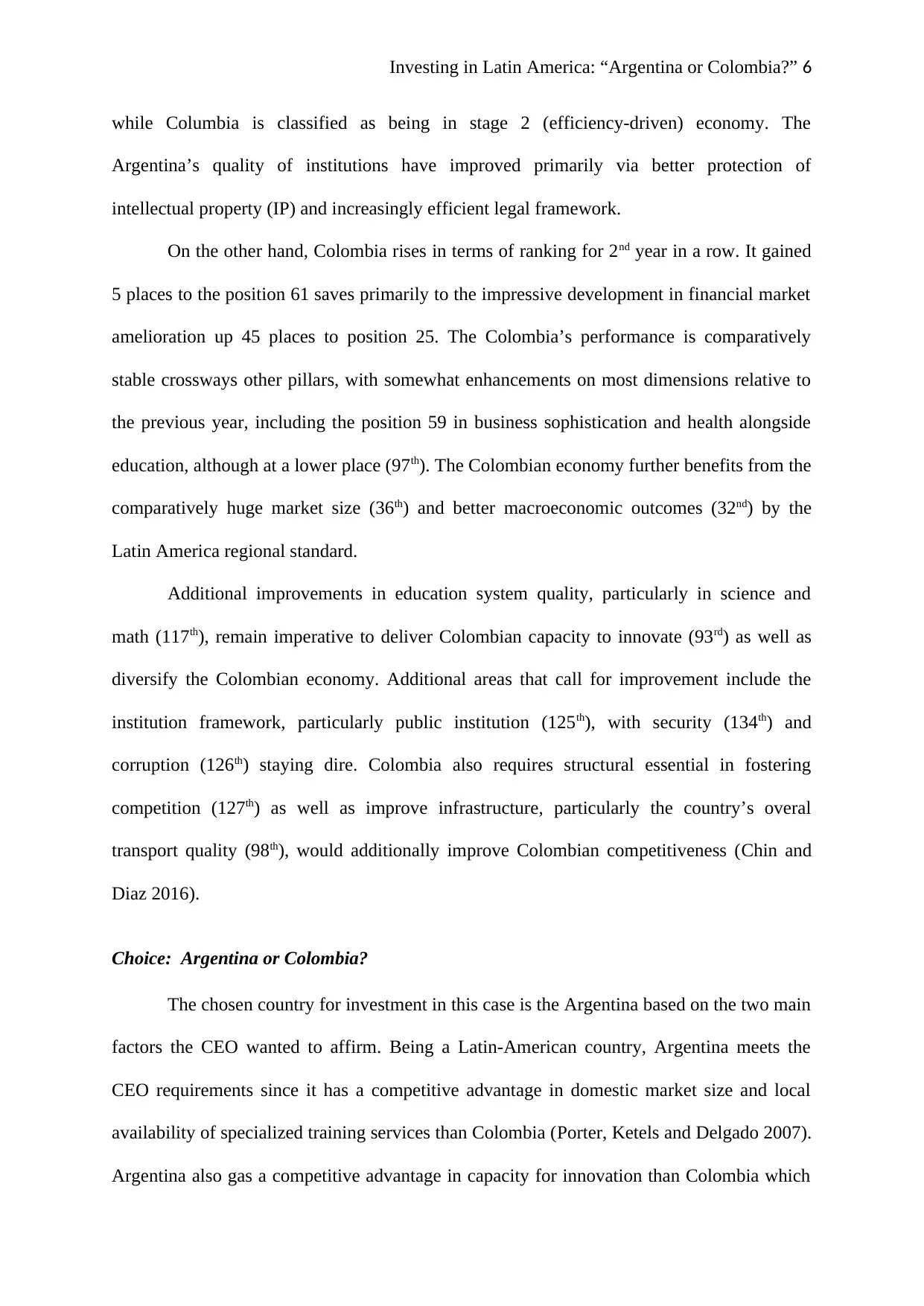
Investing in Latin America: “Argentina or Colombia?” 6
while Columbia is classified as being in stage 2 (efficiency-driven) economy. The
Argentina’s quality of institutions have improved primarily via better protection of
intellectual property (IP) and increasingly efficient legal framework.
On the other hand, Colombia rises in terms of ranking for 2nd year in a row. It gained
5 places to the position 61 saves primarily to the impressive development in financial market
amelioration up 45 places to position 25. The Colombia’s performance is comparatively
stable crossways other pillars, with somewhat enhancements on most dimensions relative to
the previous year, including the position 59 in business sophistication and health alongside
education, although at a lower place (97th). The Colombian economy further benefits from the
comparatively huge market size (36th) and better macroeconomic outcomes (32nd) by the
Latin America regional standard.
Additional improvements in education system quality, particularly in science and
math (117th), remain imperative to deliver Colombian capacity to innovate (93rd) as well as
diversify the Colombian economy. Additional areas that call for improvement include the
institution framework, particularly public institution (125th), with security (134th) and
corruption (126th) staying dire. Colombia also requires structural essential in fostering
competition (127th) as well as improve infrastructure, particularly the country’s overal
transport quality (98th), would additionally improve Colombian competitiveness (Chin and
Diaz 2016).
Choice: Argentina or Colombia?
The chosen country for investment in this case is the Argentina based on the two main
factors the CEO wanted to affirm. Being a Latin-American country, Argentina meets the
CEO requirements since it has a competitive advantage in domestic market size and local
availability of specialized training services than Colombia (Porter, Ketels and Delgado 2007).
Argentina also gas a competitive advantage in capacity for innovation than Colombia which
while Columbia is classified as being in stage 2 (efficiency-driven) economy. The
Argentina’s quality of institutions have improved primarily via better protection of
intellectual property (IP) and increasingly efficient legal framework.
On the other hand, Colombia rises in terms of ranking for 2nd year in a row. It gained
5 places to the position 61 saves primarily to the impressive development in financial market
amelioration up 45 places to position 25. The Colombia’s performance is comparatively
stable crossways other pillars, with somewhat enhancements on most dimensions relative to
the previous year, including the position 59 in business sophistication and health alongside
education, although at a lower place (97th). The Colombian economy further benefits from the
comparatively huge market size (36th) and better macroeconomic outcomes (32nd) by the
Latin America regional standard.
Additional improvements in education system quality, particularly in science and
math (117th), remain imperative to deliver Colombian capacity to innovate (93rd) as well as
diversify the Colombian economy. Additional areas that call for improvement include the
institution framework, particularly public institution (125th), with security (134th) and
corruption (126th) staying dire. Colombia also requires structural essential in fostering
competition (127th) as well as improve infrastructure, particularly the country’s overal
transport quality (98th), would additionally improve Colombian competitiveness (Chin and
Diaz 2016).
Choice: Argentina or Colombia?
The chosen country for investment in this case is the Argentina based on the two main
factors the CEO wanted to affirm. Being a Latin-American country, Argentina meets the
CEO requirements since it has a competitive advantage in domestic market size and local
availability of specialized training services than Colombia (Porter, Ketels and Delgado 2007).
Argentina also gas a competitive advantage in capacity for innovation than Colombia which
⊘ This is a preview!⊘
Do you want full access?
Subscribe today to unlock all pages.

Trusted by 1+ million students worldwide
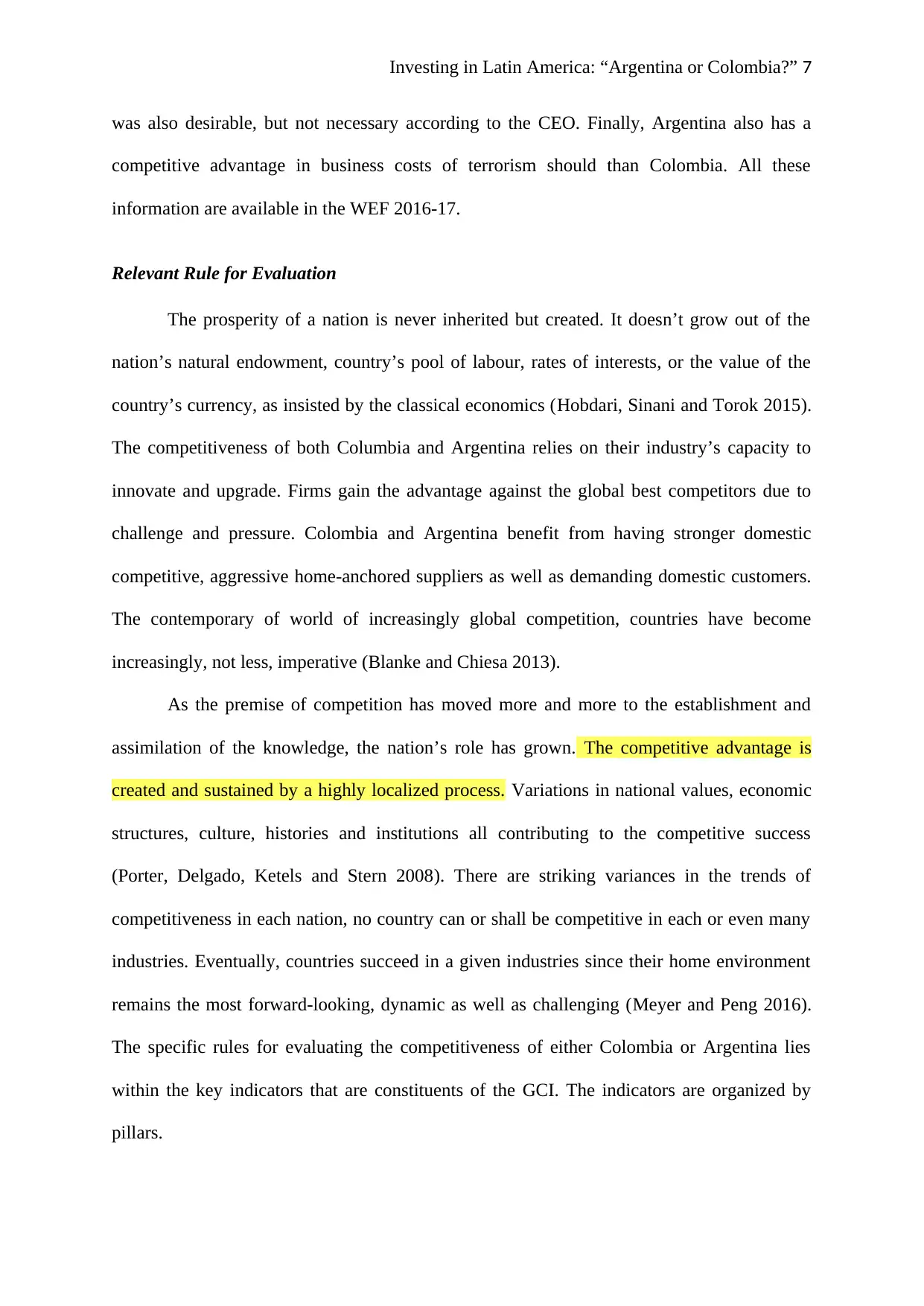
Investing in Latin America: “Argentina or Colombia?” 7
was also desirable, but not necessary according to the CEO. Finally, Argentina also has a
competitive advantage in business costs of terrorism should than Colombia. All these
information are available in the WEF 2016-17.
Relevant Rule for Evaluation
The prosperity of a nation is never inherited but created. It doesn’t grow out of the
nation’s natural endowment, country’s pool of labour, rates of interests, or the value of the
country’s currency, as insisted by the classical economics (Hobdari, Sinani and Torok 2015).
The competitiveness of both Columbia and Argentina relies on their industry’s capacity to
innovate and upgrade. Firms gain the advantage against the global best competitors due to
challenge and pressure. Colombia and Argentina benefit from having stronger domestic
competitive, aggressive home-anchored suppliers as well as demanding domestic customers.
The contemporary of world of increasingly global competition, countries have become
increasingly, not less, imperative (Blanke and Chiesa 2013).
As the premise of competition has moved more and more to the establishment and
assimilation of the knowledge, the nation’s role has grown. The competitive advantage is
created and sustained by a highly localized process. Variations in national values, economic
structures, culture, histories and institutions all contributing to the competitive success
(Porter, Delgado, Ketels and Stern 2008). There are striking variances in the trends of
competitiveness in each nation, no country can or shall be competitive in each or even many
industries. Eventually, countries succeed in a given industries since their home environment
remains the most forward-looking, dynamic as well as challenging (Meyer and Peng 2016).
The specific rules for evaluating the competitiveness of either Colombia or Argentina lies
within the key indicators that are constituents of the GCI. The indicators are organized by
pillars.
was also desirable, but not necessary according to the CEO. Finally, Argentina also has a
competitive advantage in business costs of terrorism should than Colombia. All these
information are available in the WEF 2016-17.
Relevant Rule for Evaluation
The prosperity of a nation is never inherited but created. It doesn’t grow out of the
nation’s natural endowment, country’s pool of labour, rates of interests, or the value of the
country’s currency, as insisted by the classical economics (Hobdari, Sinani and Torok 2015).
The competitiveness of both Columbia and Argentina relies on their industry’s capacity to
innovate and upgrade. Firms gain the advantage against the global best competitors due to
challenge and pressure. Colombia and Argentina benefit from having stronger domestic
competitive, aggressive home-anchored suppliers as well as demanding domestic customers.
The contemporary of world of increasingly global competition, countries have become
increasingly, not less, imperative (Blanke and Chiesa 2013).
As the premise of competition has moved more and more to the establishment and
assimilation of the knowledge, the nation’s role has grown. The competitive advantage is
created and sustained by a highly localized process. Variations in national values, economic
structures, culture, histories and institutions all contributing to the competitive success
(Porter, Delgado, Ketels and Stern 2008). There are striking variances in the trends of
competitiveness in each nation, no country can or shall be competitive in each or even many
industries. Eventually, countries succeed in a given industries since their home environment
remains the most forward-looking, dynamic as well as challenging (Meyer and Peng 2016).
The specific rules for evaluating the competitiveness of either Colombia or Argentina lies
within the key indicators that are constituents of the GCI. The indicators are organized by
pillars.
Paraphrase This Document
Need a fresh take? Get an instant paraphrase of this document with our AI Paraphraser
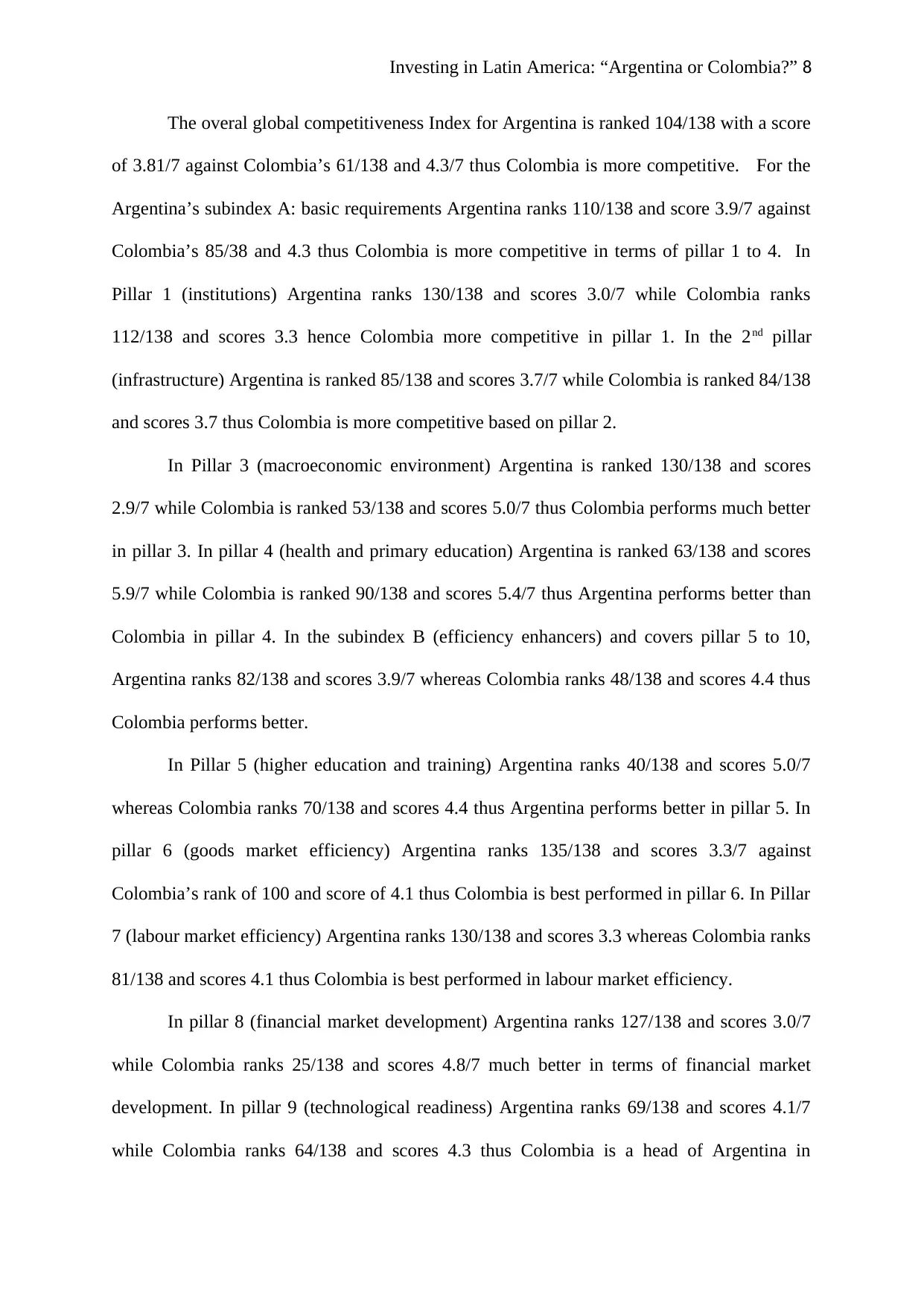
Investing in Latin America: “Argentina or Colombia?” 8
The overal global competitiveness Index for Argentina is ranked 104/138 with a score
of 3.81/7 against Colombia’s 61/138 and 4.3/7 thus Colombia is more competitive. For the
Argentina’s subindex A: basic requirements Argentina ranks 110/138 and score 3.9/7 against
Colombia’s 85/38 and 4.3 thus Colombia is more competitive in terms of pillar 1 to 4. In
Pillar 1 (institutions) Argentina ranks 130/138 and scores 3.0/7 while Colombia ranks
112/138 and scores 3.3 hence Colombia more competitive in pillar 1. In the 2nd pillar
(infrastructure) Argentina is ranked 85/138 and scores 3.7/7 while Colombia is ranked 84/138
and scores 3.7 thus Colombia is more competitive based on pillar 2.
In Pillar 3 (macroeconomic environment) Argentina is ranked 130/138 and scores
2.9/7 while Colombia is ranked 53/138 and scores 5.0/7 thus Colombia performs much better
in pillar 3. In pillar 4 (health and primary education) Argentina is ranked 63/138 and scores
5.9/7 while Colombia is ranked 90/138 and scores 5.4/7 thus Argentina performs better than
Colombia in pillar 4. In the subindex B (efficiency enhancers) and covers pillar 5 to 10,
Argentina ranks 82/138 and scores 3.9/7 whereas Colombia ranks 48/138 and scores 4.4 thus
Colombia performs better.
In Pillar 5 (higher education and training) Argentina ranks 40/138 and scores 5.0/7
whereas Colombia ranks 70/138 and scores 4.4 thus Argentina performs better in pillar 5. In
pillar 6 (goods market efficiency) Argentina ranks 135/138 and scores 3.3/7 against
Colombia’s rank of 100 and score of 4.1 thus Colombia is best performed in pillar 6. In Pillar
7 (labour market efficiency) Argentina ranks 130/138 and scores 3.3 whereas Colombia ranks
81/138 and scores 4.1 thus Colombia is best performed in labour market efficiency.
In pillar 8 (financial market development) Argentina ranks 127/138 and scores 3.0/7
while Colombia ranks 25/138 and scores 4.8/7 much better in terms of financial market
development. In pillar 9 (technological readiness) Argentina ranks 69/138 and scores 4.1/7
while Colombia ranks 64/138 and scores 4.3 thus Colombia is a head of Argentina in
The overal global competitiveness Index for Argentina is ranked 104/138 with a score
of 3.81/7 against Colombia’s 61/138 and 4.3/7 thus Colombia is more competitive. For the
Argentina’s subindex A: basic requirements Argentina ranks 110/138 and score 3.9/7 against
Colombia’s 85/38 and 4.3 thus Colombia is more competitive in terms of pillar 1 to 4. In
Pillar 1 (institutions) Argentina ranks 130/138 and scores 3.0/7 while Colombia ranks
112/138 and scores 3.3 hence Colombia more competitive in pillar 1. In the 2nd pillar
(infrastructure) Argentina is ranked 85/138 and scores 3.7/7 while Colombia is ranked 84/138
and scores 3.7 thus Colombia is more competitive based on pillar 2.
In Pillar 3 (macroeconomic environment) Argentina is ranked 130/138 and scores
2.9/7 while Colombia is ranked 53/138 and scores 5.0/7 thus Colombia performs much better
in pillar 3. In pillar 4 (health and primary education) Argentina is ranked 63/138 and scores
5.9/7 while Colombia is ranked 90/138 and scores 5.4/7 thus Argentina performs better than
Colombia in pillar 4. In the subindex B (efficiency enhancers) and covers pillar 5 to 10,
Argentina ranks 82/138 and scores 3.9/7 whereas Colombia ranks 48/138 and scores 4.4 thus
Colombia performs better.
In Pillar 5 (higher education and training) Argentina ranks 40/138 and scores 5.0/7
whereas Colombia ranks 70/138 and scores 4.4 thus Argentina performs better in pillar 5. In
pillar 6 (goods market efficiency) Argentina ranks 135/138 and scores 3.3/7 against
Colombia’s rank of 100 and score of 4.1 thus Colombia is best performed in pillar 6. In Pillar
7 (labour market efficiency) Argentina ranks 130/138 and scores 3.3 whereas Colombia ranks
81/138 and scores 4.1 thus Colombia is best performed in labour market efficiency.
In pillar 8 (financial market development) Argentina ranks 127/138 and scores 3.0/7
while Colombia ranks 25/138 and scores 4.8/7 much better in terms of financial market
development. In pillar 9 (technological readiness) Argentina ranks 69/138 and scores 4.1/7
while Colombia ranks 64/138 and scores 4.3 thus Colombia is a head of Argentina in
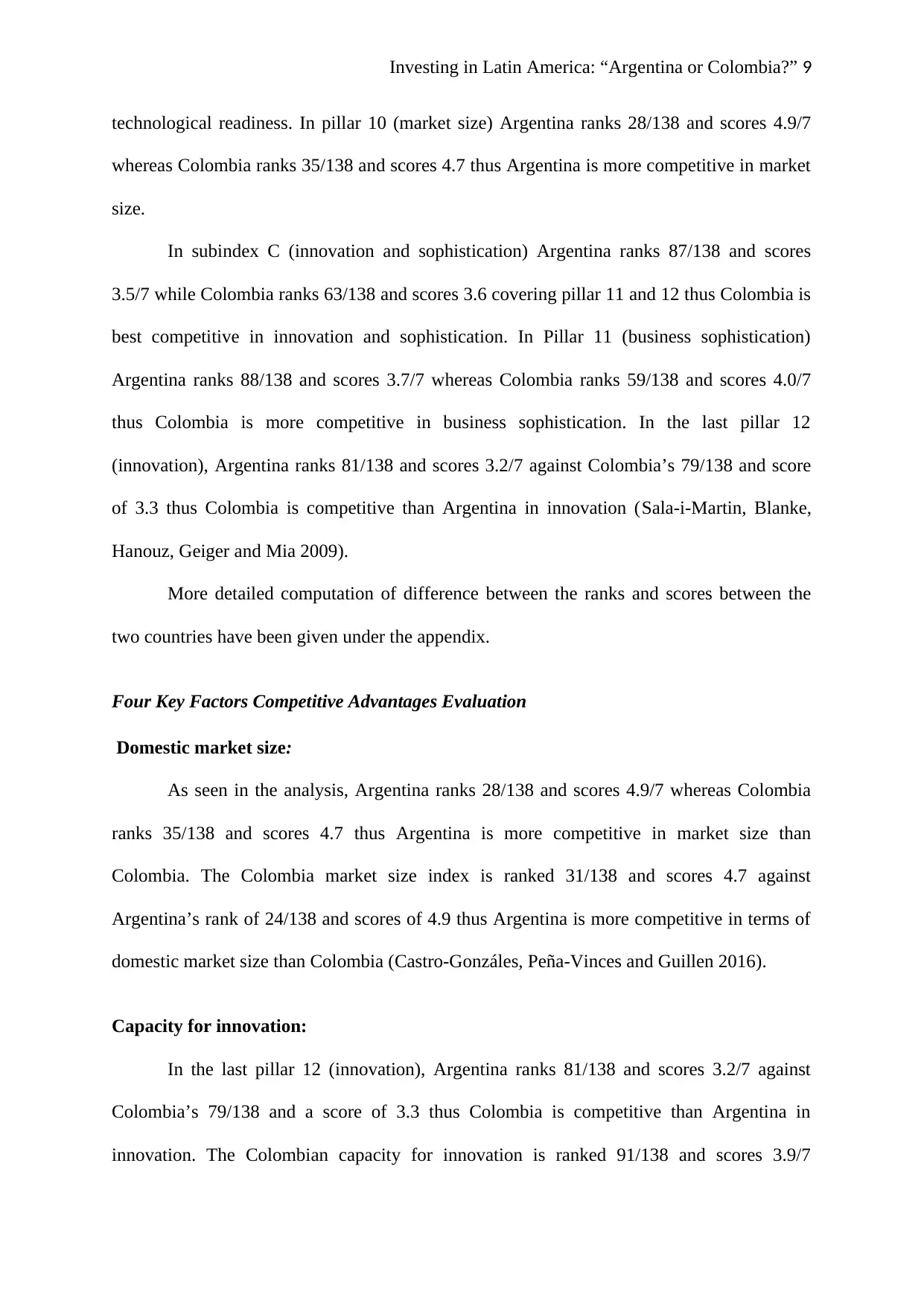
Investing in Latin America: “Argentina or Colombia?” 9
technological readiness. In pillar 10 (market size) Argentina ranks 28/138 and scores 4.9/7
whereas Colombia ranks 35/138 and scores 4.7 thus Argentina is more competitive in market
size.
In subindex C (innovation and sophistication) Argentina ranks 87/138 and scores
3.5/7 while Colombia ranks 63/138 and scores 3.6 covering pillar 11 and 12 thus Colombia is
best competitive in innovation and sophistication. In Pillar 11 (business sophistication)
Argentina ranks 88/138 and scores 3.7/7 whereas Colombia ranks 59/138 and scores 4.0/7
thus Colombia is more competitive in business sophistication. In the last pillar 12
(innovation), Argentina ranks 81/138 and scores 3.2/7 against Colombia’s 79/138 and score
of 3.3 thus Colombia is competitive than Argentina in innovation (Sala-i-Martin, Blanke,
Hanouz, Geiger and Mia 2009).
More detailed computation of difference between the ranks and scores between the
two countries have been given under the appendix.
Four Key Factors Competitive Advantages Evaluation
Domestic market size:
As seen in the analysis, Argentina ranks 28/138 and scores 4.9/7 whereas Colombia
ranks 35/138 and scores 4.7 thus Argentina is more competitive in market size than
Colombia. The Colombia market size index is ranked 31/138 and scores 4.7 against
Argentina’s rank of 24/138 and scores of 4.9 thus Argentina is more competitive in terms of
domestic market size than Colombia (Castro-Gonzáles, Peña-Vinces and Guillen 2016).
Capacity for innovation:
In the last pillar 12 (innovation), Argentina ranks 81/138 and scores 3.2/7 against
Colombia’s 79/138 and a score of 3.3 thus Colombia is competitive than Argentina in
innovation. The Colombian capacity for innovation is ranked 91/138 and scores 3.9/7
technological readiness. In pillar 10 (market size) Argentina ranks 28/138 and scores 4.9/7
whereas Colombia ranks 35/138 and scores 4.7 thus Argentina is more competitive in market
size.
In subindex C (innovation and sophistication) Argentina ranks 87/138 and scores
3.5/7 while Colombia ranks 63/138 and scores 3.6 covering pillar 11 and 12 thus Colombia is
best competitive in innovation and sophistication. In Pillar 11 (business sophistication)
Argentina ranks 88/138 and scores 3.7/7 whereas Colombia ranks 59/138 and scores 4.0/7
thus Colombia is more competitive in business sophistication. In the last pillar 12
(innovation), Argentina ranks 81/138 and scores 3.2/7 against Colombia’s 79/138 and score
of 3.3 thus Colombia is competitive than Argentina in innovation (Sala-i-Martin, Blanke,
Hanouz, Geiger and Mia 2009).
More detailed computation of difference between the ranks and scores between the
two countries have been given under the appendix.
Four Key Factors Competitive Advantages Evaluation
Domestic market size:
As seen in the analysis, Argentina ranks 28/138 and scores 4.9/7 whereas Colombia
ranks 35/138 and scores 4.7 thus Argentina is more competitive in market size than
Colombia. The Colombia market size index is ranked 31/138 and scores 4.7 against
Argentina’s rank of 24/138 and scores of 4.9 thus Argentina is more competitive in terms of
domestic market size than Colombia (Castro-Gonzáles, Peña-Vinces and Guillen 2016).
Capacity for innovation:
In the last pillar 12 (innovation), Argentina ranks 81/138 and scores 3.2/7 against
Colombia’s 79/138 and a score of 3.3 thus Colombia is competitive than Argentina in
innovation. The Colombian capacity for innovation is ranked 91/138 and scores 3.9/7
⊘ This is a preview!⊘
Do you want full access?
Subscribe today to unlock all pages.

Trusted by 1+ million students worldwide

Investing in Latin America: “Argentina or Colombia?” 10
whereas Argentina’s is ranked 74/138 and scores 4.1/7. In this case, Argentina is more
competitive than Colombia based on capacity for invocation.
Local availability of specialized training services:
Based on pillar 5 (higher education and training), the local availability of specialized
training services in Colombia is ranked 80/138 with a score of 4.1 whereas Argentina is
ranked 43/138 and scores 4.8/7. In this case, Argentina is more competitive than Colombia.
Business costs of terrorism:
Based on pillar 1 (institutions), the business costs of terrorism in Colombia is ranked
133/138 and scores 2.9 whereas Argentina’s business cost of terrorisms is ranked 51/138 and
scores 5.5 thus Argentina has competitive advantage in terms of business costs of terrorism.
To sum up, in term of the four factors, Argentina has a competitive advantage over Colombia.
CONCLUSION
The main reason for recommending Argentina as the destination for the investment is
that it has a competitive advantage in all the four key factors that the CEO wanted to be used
for making decisions. It is true that Argentina has outperformed Colombia in terms of
domestic market size, business cost of terrorism, local availability of specialized training
services as well as capacity for innovation. Being the main premises that the CEO wanted the
decision to be anchored, it is confirmed that Argentina stands to be the best destination.
Nevertheless, it was a misinformation for the external report by the consultant to purport that
the WEF lacked certain information on factors “capacity for innovation” and “business costs
of terrorism. These information are clearly highlighted in the WEF 2016-17 under the title
“The Global Competitiveness Index in detail”.
whereas Argentina’s is ranked 74/138 and scores 4.1/7. In this case, Argentina is more
competitive than Colombia based on capacity for invocation.
Local availability of specialized training services:
Based on pillar 5 (higher education and training), the local availability of specialized
training services in Colombia is ranked 80/138 with a score of 4.1 whereas Argentina is
ranked 43/138 and scores 4.8/7. In this case, Argentina is more competitive than Colombia.
Business costs of terrorism:
Based on pillar 1 (institutions), the business costs of terrorism in Colombia is ranked
133/138 and scores 2.9 whereas Argentina’s business cost of terrorisms is ranked 51/138 and
scores 5.5 thus Argentina has competitive advantage in terms of business costs of terrorism.
To sum up, in term of the four factors, Argentina has a competitive advantage over Colombia.
CONCLUSION
The main reason for recommending Argentina as the destination for the investment is
that it has a competitive advantage in all the four key factors that the CEO wanted to be used
for making decisions. It is true that Argentina has outperformed Colombia in terms of
domestic market size, business cost of terrorism, local availability of specialized training
services as well as capacity for innovation. Being the main premises that the CEO wanted the
decision to be anchored, it is confirmed that Argentina stands to be the best destination.
Nevertheless, it was a misinformation for the external report by the consultant to purport that
the WEF lacked certain information on factors “capacity for innovation” and “business costs
of terrorism. These information are clearly highlighted in the WEF 2016-17 under the title
“The Global Competitiveness Index in detail”.
Paraphrase This Document
Need a fresh take? Get an instant paraphrase of this document with our AI Paraphraser
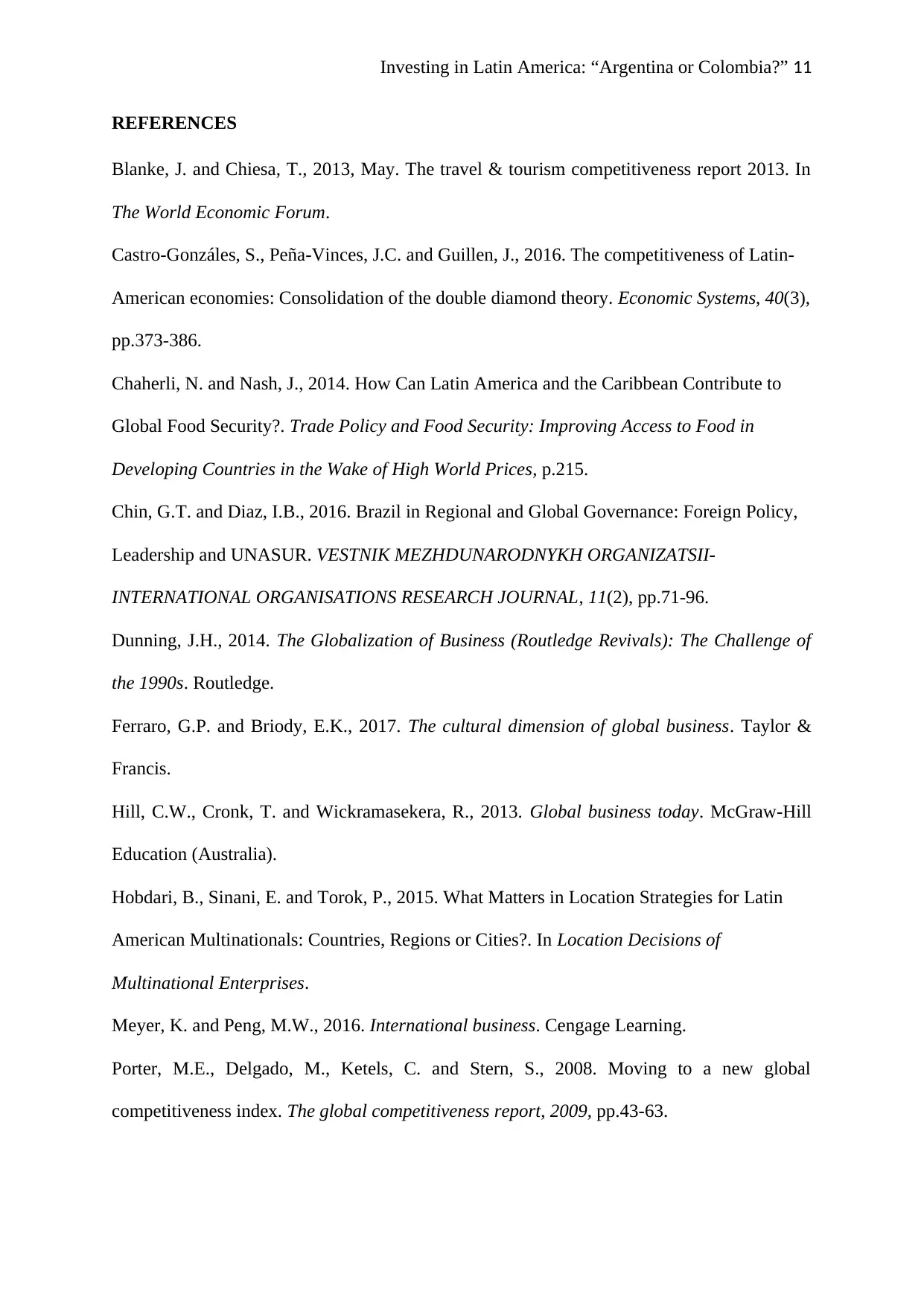
Investing in Latin America: “Argentina or Colombia?” 11
REFERENCES
Blanke, J. and Chiesa, T., 2013, May. The travel & tourism competitiveness report 2013. In
The World Economic Forum.
Castro-Gonzáles, S., Peña-Vinces, J.C. and Guillen, J., 2016. The competitiveness of Latin-
American economies: Consolidation of the double diamond theory. Economic Systems, 40(3),
pp.373-386.
Chaherli, N. and Nash, J., 2014. How Can Latin America and the Caribbean Contribute to
Global Food Security?. Trade Policy and Food Security: Improving Access to Food in
Developing Countries in the Wake of High World Prices, p.215.
Chin, G.T. and Diaz, I.B., 2016. Brazil in Regional and Global Governance: Foreign Policy,
Leadership and UNASUR. VESTNIK MEZHDUNARODNYKH ORGANIZATSII-
INTERNATIONAL ORGANISATIONS RESEARCH JOURNAL, 11(2), pp.71-96.
Dunning, J.H., 2014. The Globalization of Business (Routledge Revivals): The Challenge of
the 1990s. Routledge.
Ferraro, G.P. and Briody, E.K., 2017. The cultural dimension of global business. Taylor &
Francis.
Hill, C.W., Cronk, T. and Wickramasekera, R., 2013. Global business today. McGraw-Hill
Education (Australia).
Hobdari, B., Sinani, E. and Torok, P., 2015. What Matters in Location Strategies for Latin
American Multinationals: Countries, Regions or Cities?. In Location Decisions of
Multinational Enterprises.
Meyer, K. and Peng, M.W., 2016. International business. Cengage Learning.
Porter, M.E., Delgado, M., Ketels, C. and Stern, S., 2008. Moving to a new global
competitiveness index. The global competitiveness report, 2009, pp.43-63.
REFERENCES
Blanke, J. and Chiesa, T., 2013, May. The travel & tourism competitiveness report 2013. In
The World Economic Forum.
Castro-Gonzáles, S., Peña-Vinces, J.C. and Guillen, J., 2016. The competitiveness of Latin-
American economies: Consolidation of the double diamond theory. Economic Systems, 40(3),
pp.373-386.
Chaherli, N. and Nash, J., 2014. How Can Latin America and the Caribbean Contribute to
Global Food Security?. Trade Policy and Food Security: Improving Access to Food in
Developing Countries in the Wake of High World Prices, p.215.
Chin, G.T. and Diaz, I.B., 2016. Brazil in Regional and Global Governance: Foreign Policy,
Leadership and UNASUR. VESTNIK MEZHDUNARODNYKH ORGANIZATSII-
INTERNATIONAL ORGANISATIONS RESEARCH JOURNAL, 11(2), pp.71-96.
Dunning, J.H., 2014. The Globalization of Business (Routledge Revivals): The Challenge of
the 1990s. Routledge.
Ferraro, G.P. and Briody, E.K., 2017. The cultural dimension of global business. Taylor &
Francis.
Hill, C.W., Cronk, T. and Wickramasekera, R., 2013. Global business today. McGraw-Hill
Education (Australia).
Hobdari, B., Sinani, E. and Torok, P., 2015. What Matters in Location Strategies for Latin
American Multinationals: Countries, Regions or Cities?. In Location Decisions of
Multinational Enterprises.
Meyer, K. and Peng, M.W., 2016. International business. Cengage Learning.
Porter, M.E., Delgado, M., Ketels, C. and Stern, S., 2008. Moving to a new global
competitiveness index. The global competitiveness report, 2009, pp.43-63.

Investing in Latin America: “Argentina or Colombia?” 12
Porter, M.E., Ketels, C. and Delgado, M., 2007. The microeconomic foundations of
prosperity: findings from the business competitiveness index. The Global Competitiveness
Report 2007–2008, pp.51-81.
Sala-i-Martin, X., Blanke, J., Hanouz, M.D., Geiger, T. and Mia, I., 2009. The global
competitiveness index 2009–2010: Contributing to long-term prosperity amid the global
economic crisis. The global competitiveness report, 2010, pp.3-47.
Schwab, K., 2010, September. The global competitiveness report 2010-2011. Geneva: World
Economic Forum.
Sheng, H.H. and Carrera Júnior, J.M., 2016. Leading brazilian multinational enterprises:
trends in an era of significant uncertainties and challenges.
Porter, M.E., Ketels, C. and Delgado, M., 2007. The microeconomic foundations of
prosperity: findings from the business competitiveness index. The Global Competitiveness
Report 2007–2008, pp.51-81.
Sala-i-Martin, X., Blanke, J., Hanouz, M.D., Geiger, T. and Mia, I., 2009. The global
competitiveness index 2009–2010: Contributing to long-term prosperity amid the global
economic crisis. The global competitiveness report, 2010, pp.3-47.
Schwab, K., 2010, September. The global competitiveness report 2010-2011. Geneva: World
Economic Forum.
Sheng, H.H. and Carrera Júnior, J.M., 2016. Leading brazilian multinational enterprises:
trends in an era of significant uncertainties and challenges.
⊘ This is a preview!⊘
Do you want full access?
Subscribe today to unlock all pages.

Trusted by 1+ million students worldwide
1 out of 16